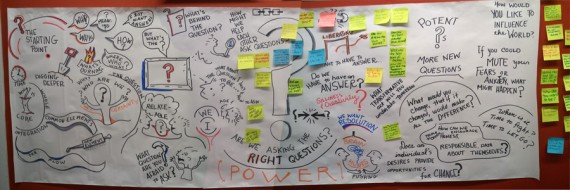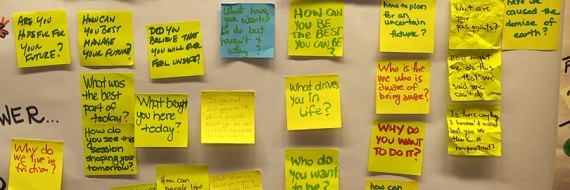In life we ask questions to elicit information we need. But the questions we ask may not motivate people to deeply reflect, or inspire a careful response. The idea of exchanging information through questions and answers is something that we take for granted. We don’t always think if the question is the right one or if the answer needs more thought. It is unfortunate because great questions can be the inspiration for groundbreaking or alternative solutions, especially in design.

So on September 14, 2011 I had a chance to explore these issues. I joined a discussion along with 30 other people led by Dr. Peter Jones at Design with Dialogue that asked “Can a powerful question change the world?” We started our discussion with the question “What question is burning to be asked in your life right now?” Although simple enough, we wondered how this question worked for us and spent some time doing other exercises before we explored it further.
During the DwD session we practiced different methods of exploring the impact of what powerful questions could produce. The session was divided into three separate challenges. The first one was called the question game, in which participants engaged in conversations that were entirely made from questions. The second challenge was to look carefully at the process and practice of asking questions. The third and final challenge was to explore how questions might direct a purposeful, intended response.
The first challenge was particularly interesting. Only asking questions to continue a conversation is incredibly difficult, and I might add, awkward. As performed in this exercise it literally hurt our brains. Sometimes as a participant I found this method of conversation argumentative or even aggressive. It sometimes felt that the other person was not listening and you wanted to shut the conversation down. On the other hand — and depending upon the other person involved — the conversation became silly. In some ways, not having to answer the questions took the pressure off because you didn’t have to be the expert or the one with the answer. One person noted, “It’s almost like two magnets pushing against each other.”
The second challenge was broken down into three other questions:
1. What is the function of the question?
2. What is the effect of a question on the person being asked?
3. What kinds of questions have potential to engage a better experience?
Albeit not as silly as the first challenge it became apparent that there are many facets to fully understanding questions. For example, when characterizing the question being asked we sometimes look at the energy or enthusiasm of the person asking, the scale of the real problem being addressed or even the age of a person taking the lead. For instance, if the person is younger there might be more time to solve the issue, whereas, if that person is older they might have more knowledge to bear. Questions might be mere inquiries, examinations or research. They might be asked in an exclusionary or an inclusive way, and depending on how we view the question it will affect how we answer. There were many more ideas that came out of this challenge, too many to mention but it suffices to say that these were simple questions that produced a lively debate. By the end of this challenge it was obvious how creatives could better use this knowledge to build better opportunities with their clients.

The third challenge produced a plethora of ‘post it notes’ that covered many different questions from the audience as noted in the picture are below.

Questioning myself
In the end I realized the most important thing to do is ask the right question. Far too many people have an answer already in mind when they ask, or the question they ask is too vague. I know in the future the way I ask and the way someone responds is something I will be looking at more carefully.